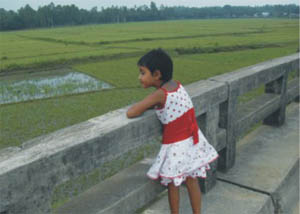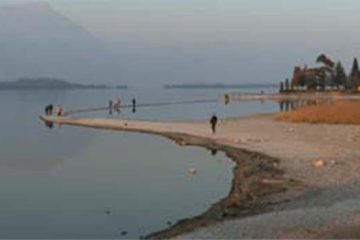Biodiversity
Dewpara Sal forest: Past and present
Dr. Md. Mizanur Rahman
 SAL occurs on the southern slopes of the Himalayas in Nepal, India and Bangladesh. In India Sal occupies the northern and central regions separated by the Gangetic plain. Terai (low land) is considered as the main Sal growing region of Nepal. The major portion of Sal forests in Bangladesh is located in the central parts (Mymensingh, Tangail and Gazipur).
SAL occurs on the southern slopes of the Himalayas in Nepal, India and Bangladesh. In India Sal occupies the northern and central regions separated by the Gangetic plain. Terai (low land) is considered as the main Sal growing region of Nepal. The major portion of Sal forests in Bangladesh is located in the central parts (Mymensingh, Tangail and Gazipur).
Sal forest is the most threatened and vulnerable ecosystem of Bangladesh. Until the beginning of the 20th century, these forests existed as a continuous belt with rich floral and faunal diversity. Gradually increasing population put tremendous pressure on this ecosystem and changed the scenario. These forests at present are under occupation and the remaining stands are of poor stocking. The massive destruction of Sal forests of Bangladesh occurred during the last 40 years. Biodiversity has declined rapidly and many species have disappeared.
The Sal forests are acutely impacted by over-exploitation, deforestation, excessive litter collection, encroachment, indiscriminate collection of economically important plant species (i.e. medicinal, fodder etc), and other forms of anthropogenic disturbances. Natural Sal forests have been converted into plantation forests, rotational forests, exotic woodlands, rubber gardens, banana gardens, pineapple orchards, rice field, homesteads and other agricultural fields.
Dewapara Sal forest is under the Dholapara range of Tangail. Few decades ago it was attached with Madhupur Sal forests as a continuous forest belt. The total area of forest land is 1500-acre, out of which 800-acre has forest coverage. Only 10-acre area has Sal patches and the rest 790-acre is occupied by 10 years long rotational plantation forest. The Sal patches are highly degraded, fragmented, mostly denuded and made mono-species based. This area falls under the bio-ecological zone of Madhupur Tract. The soil represents highly oxidized reddish brown clay containing ferruginous nodules and manganese spots. The whole forest areas are fragmented by an intricate network of depressions in honeycomb pattern layout. The depressions are generally cultivated with paddy. Homesteads, cultivable lands and forests are mixed which makes forest boundary demarcation and maintenance extremely difficult.
Biodiversity at present
Flora
Among the natural tree species, Sal is found sporadically in the above mentioned 10-acre area. With few exceptions, the diameter at breast height (DBH) of the Sal trees ranges from 10-30 cm. The height of the mature Sal tree will not exceed 20 m. No other natural Sal associates are present in this forest area. The rotational plantation forests are dominated by Acacia, Mangium and Eucalyptus. The exotic species in the plantation forests are uniformly distributed, where Sal is randomly distributed in patches. Natural regeneration (ephemeral, established seedling and sapling) are totally absent. Few juvenile Sal trees can be found occasionally. Without the continuity of natural regeneration it is not possible to maintain a natural ecosystem. Bhite and Mouhati are the dominant shrubs in both Sal patches and plantation forests. Among the herbs only Basket Grass, Foxtail and Love Thorn are available in this area. Climbers are totally absent in these forests. There is no trace of coarse woody debris and mycorrhizal association. Consequently the species richness, diversity index (Shannon-Wiener index) and evenness (Pielou’s index) are very low. Due to poor species richness the concentration of dominance (Simpson index) is very high.
Fauna
Among the bird species, the Common Mayna (Shalik), Spotted Dove (Ghughu) and Oriental Magpie Robin (Doyel) are found occasionally. Fox and Squirrel are rarely distributed in this ecosystem.
Biodiversity in the past
Flora
Tree: Even 40 years back the Sal forest was the richest biodiversity spot of Bangladesh. Sal was the dominant species followed by Bangajari, Gandhigajari, Sindhuri, Datoi, Ajuli, Dud Koroi, Bhutum, Bohera, Haritaki, Arjun, Sonalu, Cheshra, Jiga, Jogini Chakra, Kaika, Sidha, Sajna, Amloki, Roina, Lalmoina, Tamal, Khailadamor, Kak dumur, Faska dumur, Olotkomol, Chatim, Neor, Minjiri, Pakor, Shilabadi, Haldu, Kurchi, Mohuya, Kharajora, Kanaidinga, Kukurchita, Katakhai, Udhal, Sheora, Pahariamra, Awal, Koroch, Bajna, Joina, Debdaru, and Behula.
Shrub: Anaigota was dominant species followed by Fulkhari, Monkata, Chokoi, Piralo, Chutkigota, Chhitki, Bishkanthali, Tagor, Bhite, Nishinda and Mouhati.
Herb: Sungrass was the dominant species followed by Soti, Bishkachu, Fulkori, Basket Grass, Ufatlangra, Foxtail, Carpet Grass and Thankoni.
Climbers: Bidipata was the dominant species followed by Gaza Pipul, Pipul, Shimul Lata, Patilalau, Paniyalata, Dumurlata, Chai, Kumarilata, Harjora, Shotomuli, Natakaranj, Keoyakanthal, Makal, Bishuti, Telakucha, Meta Alu, Bish Alu, Garo Alu, Gachh Alu, Jhum Alu, Shuori Alu and German Lata.
Mycorrhiza: Different genera of mycorrhiza were associated with matured Sal trees. Russula was the most frequent occurring followed by Amanita, Laccari and Scleroderma .
Fauna
Once upon a time these forests were very rich in faunal diversity. During the late nineteenth century Elephants and Rhinoceros became extinct from this ecosystem. The Asiatic Black Bear, Sambar Deer, Spotted Dear, Barking Deer and Red Frog disappeared just four decades ago. The Leopard Cat, Fishing Cat, Jungle Cat, Indian Civet and Capped Langur reached extinction in the recent years. This was the paradise of different indigenous birds, many amphibians and reptiles.
Conservation for the future
o Strictly controlling further logging of Sal
o Afforestation and reforestation by early successional Sal species
o Zoning the forest lands into core, buffer and peripheral zones
o Initiating conservation programme at core zone
o Gap filling by Sal associates
o Facilitating natural regeneration in adjacent areas of Sal patches
o Protecting new born seedling or ephemeral from destruction
o Stopping removal of old trees and deadwood from the forest to increase the population of different bird species and to initiate mycorrhizal associations
o Stopping further encroachment
o Rehabilitating the forest people outside the forest areas
o Creating public relations for nature conservation
o Creating alternative livelihoods for the forest people
o Supply of alternative fuel sources in the adjacent areas
o Demarcation of forest land and forest coverage
o Clear felling of all exotic trees after maturing into merchantable timber size
o Stopping further plantations of exotic species as they adversely affect the natural ecosystem
o Initiating income generating activities through microcredit programme to minimise the tremendous human pressure on forest
Image (above) caption: Conversion of natural forest into agricultural field at Dewpara
Dr. Md. Mizanur Rahman, a biodiversity specialist, is Assistant Commissioner, Jhalakathi Collectorate (mizan_peroj @yahoo.com).



